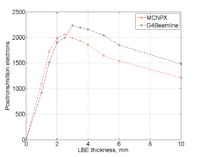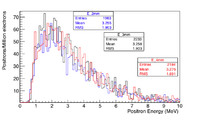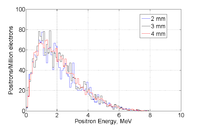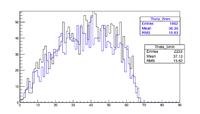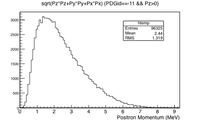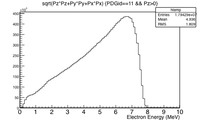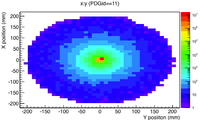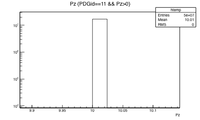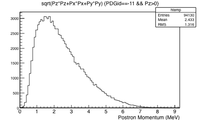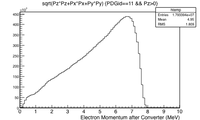Difference between revisions of "PbBi THickness GaussBeam"
(Created page with " G4Beamline_PbBi#Target_thickness_optimization") |
|||
| Line 1: | Line 1: | ||
| + | |||
| + | First simple test is to send 1 million, 10 MeV electrons towards a PbBi target and count how many positrons leave the downstream side | ||
| + | |||
| + | The Random number seed is set by Time in G4beamline to use a different set of pseudo random numbers each time it is run | ||
| + | |||
| + | The G4Beamlin incident electron beam has the following properties | ||
| + | |||
| + | <pre> | ||
| + | beam gaussian particle=e- nEvents=1000000 beamZ=0.0 | ||
| + | sigmaX=1.0 sigmaY=1.0 sigmaXp=0.100 sigmaYp=0.100 | ||
| + | meanMomentum=10.0 sigmaP=4.0 meanT=0.0 sigmaT=0.0 | ||
| + | </pre> | ||
| + | |||
| + | |||
| + | {| border="1" | ||
| + | {| border="1" | ||
| + | | PbBi Thickness (mm) || #positrons/million electrons (G4Beamline)|| #positrons/million electrons (MCNPX) | ||
| + | |- | ||
| + | - | ||
| + | | 1 || 960,874, 916,934,897=916 +/- 33 || 1091 | ||
| + | |- | ||
| + | | 1.5 || 1508 || 1728 | ||
| + | |- | ||
| + | | 2 || 1963,1919,1880,1877,1970 = 1902 <math>\pm</math> 43 || 1984 | ||
| + | |- | ||
| + | | 2.5 || 1997 || 2062 | ||
| + | |- | ||
| + | | 3|| 2233,2250, 2251,2226 , 2222=2236 <math>\pm</math> 13|| 1986 | ||
| + | |- | ||
| + | | 3.5|| 2193 || 1938 | ||
| + | |- | ||
| + | | 4|| 2184,2156,2089,2173,2181=2157 <math>\pm</math> 39 || 1858 | ||
| + | |- | ||
| + | | 5|| 2042 || 1646 | ||
| + | |- | ||
| + | | 6|| 1851, 1932, 1857, 1896,1924 = 1892<math> \pm</math> 37 || 1541 | ||
| + | |- | ||
| + | | 10|| 1480,1488 || 1216 | ||
| + | |- | ||
| + | |} | ||
| + | Comparison of G4Beamline and MCNPX | ||
| + | |||
| + | |||
| + | [[File:Comparison.png | 200 px]] | ||
| + | |||
| + | |||
| + | Energy Distribution | ||
| + | |||
| + | [[File:TF_PosE_04-28-15.png | 200 px]] | ||
| + | [[File:Positrons2.png | 200 px]] | ||
| + | |||
| + | Angular distribution of positrons | ||
| + | |||
| + | [[File:TF_Theta_04-28-15.png | 200 px]] | ||
| + | |||
| + | |||
| + | |||
| + | I was unable to do anything other than a gaussian beam right now, I will try to do one later | ||
| + | |||
| + | For now I have a gaussian with an 8mm RMS and 10 MeV incident electrons as shown below. | ||
| + | |||
| + | The positron and electron momentum distributions after the PbBi converter are shown below | ||
| + | |||
| + | |||
| + | [[File:4-30-2015_PositronMomentum_2mm.png| 200 px]][[File:4-30-2015_ElectronMomentum_2mm.png| 200 px]] | ||
| + | |||
| + | A comma delimited text file with the above events in the format of | ||
| + | |||
| + | x,y,z,Px,Py,Pz | ||
| + | |||
| + | in units of cm for distance and MeV for momentum is located at | ||
| + | |||
| + | for positrons | ||
| + | |||
| + | http://www2.cose.isu.edu/~foretony/Positrons_2mm10MeV.dat | ||
| + | |||
| + | |||
| + | and | ||
| + | |||
| + | http://www2.cose.isu.edu/~foretony/Electrons_2mm10MeV.dat | ||
| + | |||
| + | |||
| + | for electrons | ||
| + | |||
| + | For now I have a gaussian with an 1mm RMS and 10 MeV incident electrons as shown below. | ||
| + | |||
| + | [[File:4-30-2015_BeamPosDelta.png| 200 px]][[File:4-30-2015_ElectronMomentum.png| 200 px]] | ||
| + | |||
| + | |||
| + | The positron and electron momentum distributions after the PbBi converter are shown below | ||
| + | |||
| + | |||
| + | [[File:4-30-2015_PositronMomentum_2mmDelta.png| 200 px]][[File:4-30-2015_ElectronMomentum_2mmDelta.png| 200 px]] | ||
| + | |||
| + | A comma delimited text file with the above events in the format of | ||
| + | |||
| + | x,y,z,Px,Py,Pz | ||
| + | |||
| + | in units of cm for distance and MeV for momentum is located at | ||
| + | |||
| + | for positrons | ||
| + | |||
| + | http://www2.cose.isu.edu/~foretony/Positrons_2mm10MeVDelta.dat | ||
| + | |||
| + | |||
| + | and | ||
| + | |||
| + | http://www2.cose.isu.edu/~foretony/Electrons_2mm10MeVDelta.dat | ||
| + | |||
| + | |||
| + | for electrons | ||
[[G4Beamline_PbBi#Target_thickness_optimization]] | [[G4Beamline_PbBi#Target_thickness_optimization]] | ||
Revision as of 16:43, 1 May 2015
First simple test is to send 1 million, 10 MeV electrons towards a PbBi target and count how many positrons leave the downstream side
The Random number seed is set by Time in G4beamline to use a different set of pseudo random numbers each time it is run
The G4Beamlin incident electron beam has the following properties
beam gaussian particle=e- nEvents=1000000 beamZ=0.0
sigmaX=1.0 sigmaY=1.0 sigmaXp=0.100 sigmaYp=0.100
meanMomentum=10.0 sigmaP=4.0 meanT=0.0 sigmaT=0.0
| PbBi Thickness (mm) | #positrons/million electrons (G4Beamline) | #positrons/million electrons (MCNPX) |
| 1 | 960,874, 916,934,897=916 +/- 33 | 1091 |
| 1.5 | 1508 | 1728 |
| 2 | 1963,1919,1880,1877,1970 = 1902 43 | 1984 |
| 2.5 | 1997 | 2062 |
| 3 | 2233,2250, 2251,2226 , 2222=2236 13 | 1986 |
| 3.5 | 2193 | 1938 |
| 4 | 2184,2156,2089,2173,2181=2157 39 | 1858 |
| 5 | 2042 | 1646 |
| 6 | 1851, 1932, 1857, 1896,1924 = 1892 37 | 1541 |
| 10 | 1480,1488 | 1216 |
Comparison of G4Beamline and MCNPX
Energy Distribution
Angular distribution of positrons
I was unable to do anything other than a gaussian beam right now, I will try to do one later
For now I have a gaussian with an 8mm RMS and 10 MeV incident electrons as shown below.
The positron and electron momentum distributions after the PbBi converter are shown below
A comma delimited text file with the above events in the format of
x,y,z,Px,Py,Pz
in units of cm for distance and MeV for momentum is located at
for positrons
http://www2.cose.isu.edu/~foretony/Positrons_2mm10MeV.dat
and
http://www2.cose.isu.edu/~foretony/Electrons_2mm10MeV.dat
for electrons
For now I have a gaussian with an 1mm RMS and 10 MeV incident electrons as shown below.
The positron and electron momentum distributions after the PbBi converter are shown below
A comma delimited text file with the above events in the format of
x,y,z,Px,Py,Pz
in units of cm for distance and MeV for momentum is located at
for positrons
http://www2.cose.isu.edu/~foretony/Positrons_2mm10MeVDelta.dat
and
http://www2.cose.isu.edu/~foretony/Electrons_2mm10MeVDelta.dat
for electrons
